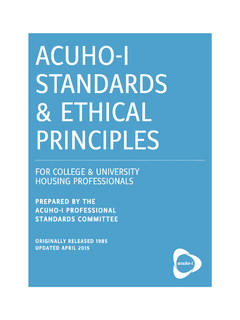Transcription of 4-H Youth Development Program
1 The University of California4-H Youth Development Programengages Youth in reaching theirfullest potential while advancingthe field of Youth Development . The California 4-H Youth Development ProgramDirections for the Decade AheadPrepared by The 4-H mission and Direction CommitteeUniversity of CaliforniaDivision of Agriculture and Natural ResourcesWinter 2003 Table of Contents3 The California 4-H Youth Development ProgramTable of ContentsTable of ContentsEXECUTIVE SUMMARY ..4 INTRODUCTION ..6 The Charge ..74-H mission and DIRECTION COMMITTEE PROCESS ..8 Committee Member Selection ..8 Role and Function ..8 SOURCES OF DATA ..10 ANR mission , Core Values and Long Term Planning Assumptions ..10 California 4-H Youth Development Program History ..10 California Demographics and Socio-Economic Indicators ..12 Research from the Field of Youth Development .
2 14 Stakeholder Input to the 4-H mission and Direction Committee ..164-H Youth Development PROGRAMMISSION and DIRECTION COMPONENTS ..17 mission Statement ..17 Brand - Name Identity ..18 Core Values ..18 Program Criteria ..20 GENERAL IMPLEMENTATION OBJECTIVES ..25 Training ..25 Tools ..25 Processes / Systems ..26 CONCLUSION ..27 REFERENCES ..29 Executive SummaryThe 4-H mission and Direction Committeewas established by the UC/ANR Vice Presidentto develop a 4-H mission Statement and aseries of priorities and recommendations toguide the California 4-H Youth Development (4-H YD) Program for the next State Director of the 4-H YouthDevelopment Program and eleven (11) 4-HYouth Development advisors and specialistsrepresenting a range of experiences andperspectives from around the state considereda variety of data sources in developing a newMission Statement and recommendationsfor the future of the 4-H YD Program data sources included theANR mission , core values, and long termplanning assumptions; 4-H historical andenrollment data; California demographicsand socio-economic indicators; researchfrom the field of Youth Development .
3 Andstakeholder following recommendations of the4-H mission and Direction Committee wereapproved by the UC/ANR Vice President inApril 2002:New 4-H Youth DevelopmentProgram mission Statement: The University of California 4-H YouthDevelopment Program engages Youth inreaching their fullest potential whileadvancing the field of Youth Development . 4-H Youth Development is thebrand-name identity for ANRyouth Development following core values willguide actions and decisionsat all levels of the 4-H YouthDevelopment organization: Support the UC/ANR mission and strategicplanning assumptions. Recognize that UC/ANR professionalsprovide the Youth Development frameworkfor volunteers and other cooperatorswho bring the knowledge, experienceand passion to work with Youth in theircommunities. Appreciate, respect and value diversitythrough a commitment to inclusion ofdiverse Californians.
4 Respond to local needs within a context ofstatewide criteria, practices and prioritiesfor 4-H Youth Development programming. Innovate to maximize impact and resourceswhile documenting the unique youthdevelopment contributions of our 4-HYouth Development following statewideCalifornia 4-H YouthDevelopment (CA 4-H YD) Program criteria will guideactions and decisions at alllevels of the organization: The CA 4-H YD Program is focused onaddressing significant environmental,economic and social issues affectingCalifornia s Youth , families and communities. The CA 4-H YD Program is based on aproven experiential education model thatcreates an educational climate throughplanned learning by exploring, doing,and receiving feedback. The CA 4-H YD Program is conducted withcontent and delivery systems consistentwith a statewide 4-H Youth developmentframework offering Citizenship, Leadershipand/or Life Skills SummaryExecutive SummaryThe California 4-H Youth Development Program4 The California 4-H Youth Development Program5 Executive SummaryExecutive Summary The CA 4-H YD Program is consistentwith research in Youth Development ,education, or other appropriate fields.
5 The CA 4-H YD Program is a contributorto research and/or the extension ofknowledge in Youth Development . The CA 4-H YD Program is able todemonstrate, or likely to demonstrate,through research and/or evaluative data,a positive impact on Youth served. The CA 4-H YD Program is connected to,or has the potential to connect to UC orother campus-based faculty, programsand/or resources. The CA 4-H YD Program is accessible andopen to diverse audiences. The CA 4-H YD Program is balanced in termsof assessing, managing, and monitoringpotential problems to ensure programsafety and achievement of key objectivesdefined by ANR s risk management Program . The CA 4-H YD Program is balanced so asto optimize the impact for clientele andthe field of Youth impactachieved will be weighed against theresources invested at the statewide andlocal recommendations for imple-mentation were reviewed by UC/ANRA dministration, who identified several toppriority objectives to be assigned to theState 4-H Office and the 4-H Center forYouth Development .
6 Among others, theseobjectives included: Develop and deliver a consistent, coordinatedstatewide communication, education andtraining (CET) campaign to educate 4-HYD Program staff, extenders and youthabout the new focus and criteria in orderto move toward a cohesive, consistentand high quality statewide Program . Develop statewide 4-H YD Programprocesses, systems, and tools to assist andsupport staff and other stakeholders intransitioning to the new mission anddirection. Engage all UC, ANR and 4-H YD Programstakeholders in resource developmentefforts to create sustainable support for4-H YD programming statewide. Commit to conducting an evaluation ofthis effort in five years to document suc-cesses, identify barriers and plan mid-course corrections that can continue theprocess of positive organizational a wide variety of deliverymethods, county and state 4-H YouthDevelopment staff will work cooperativelywith volunteer extenders, other youthserving agencies, Youth organizations andcommunity-based programs to provideeffective Youth Development opportunitiesthat will address critical California youthissues over the next is a state facing great challengesand opportunities for its Youth , families, more than nine millionyoung people representing greater diversitythan any other state in the country, Californiais facing challenges in Youth developmentand education that must be these challenges, the University ofCalifornia.
7 Division of Agriculture andNatural Resources (ANR)4-H YouthDevelopment (4-H YD) Program is uniquelypositioned to make a significant contributionthrough the delivery of 4-H YD programsthat help Youth reach their fullest potential,and through research that advances thefield of Youth Development and extendsthe impact of those trends have impacted our programsover the last state s youthpopulation has significantly increased inboth numbers and diversity, while theDivision s Youth Development workforcehas diminished and staffing patterns haveremained relatively size anddiversity of our state, including geographicdiversity, has resulted in a wide range ofprograms that are responsive to local needsand unique to their the same time,this flexibility without a statewide, cohesivefocus has allowed us to spread ourselvestoo thin in an attempt to meet all of theneeds that our public asks us to of this attempt to be all things to allpeople has meant the dissipation of theprogram s impact and , as ANR strengthens its focuson research and tightens the link betweenour research and extension efforts, 4-HYouth Development professionals havefound significant competing demands ontheir time.
8 County-based 4-H YD academicsare severely disadvantaged in their ownprofessional advancement as they try tomake an academic footprint while providingprogram management and aresult, the overall quality of the Program (not the quality of individual programs ) andits ability to provide appropriate levels ofoversight and control has been challenge of balancing innovativeacademic work with high quality programdelivery and management, given the increasingdemands of California s demographics,required that the California 4-H YouthDevelopment Program set new prioritiesand articulate a more focused vision ofwhat we can accomplish in this Vice President W. R.(Reg)Gomes gavethe charge to form a 4-H mission andDirection Committee to address theseissues and develop a series of prioritiesand recommendations for the 4-H YouthDevelopment California 4-H Youth Development Program67 IntroductionIntroductionThe California 4-H Youth Development ProgramThe ChargeSpecifically,Vice President Gomes chargedthe Committee to develop a 4-H MissionStatement; a vision for directions and priorities;and a set of realistic, high-impact goals andobjectives for the California 4-H YouthDevelopment Program for the next five toten guiding question for theCommittee was: How can the 4-H Youth DevelopmentProgram make a unique, measurableand significant difference to California syouth and to the field of Youth Development ?
9 The unique difference meant that theCommittee would need to articulate the 4-HYD Program s niche in the field of youthdevelopment; how could we continue toinnovate as an organization? The measurabledifference meant that as the Committeelooked forward, it needed to consider howwe would be able to articulate our goals andobjectives and measure our impact in achievingthem. Finally, the significant differencemeant that the Committee needed to lookat the current resources of the Program andconsider how we could leverage thoseresources most strategically to make thebiggest difference in the lives of California syouth, families and communities, and in thefield of Youth order to respond to the charge, theCommittee was also asked to address thefollowing questions: What are the appropriate areas and feasiblescope for 4-H YD activities, assumingsteady levels of funding and personnelover the next several years?
10 How would the scope of the 4-H YDProgram be enlarged if funding resources(internal or external) were to increase? What criteria should be adopted toensure that proposed new projects arealigned with the mission and directionof the 4-H YD Program ? How do currentactivities fit within those criteria? What actions need to be taken to bringcurrent activities in line with theCommittee s recommended MissionStatement and priorities? To fulfill the mission , goals and directionsdeveloped by the Committee, what is theappropriate role of advisors, programrepresentatives, other 4-H staff and volun-teers? How can we support those roles?These questions guided the work ofthe 4-H mission and Direction Committeethroughout the entire mission & Direction Committee ProcessCommittee Member SelectionIn identifying the charge for theCommittee,Vice President Gomes suggestedthat a small group of 4-H Youth Development (4-H YD) advisors and specialists be selectedto serve on the followingcriteria were developed to identify Committee members, collec-tively, would be able to provide a range ofexperience and perspectives, based on: Distribution among UC/ANRadministrative regions; Geographic diversity (rural, urban,suburban settings); Experience in a range of 4-H YDprograms (including clubs, after-school,school enrichment, etc.)






